|
|
Kendal

|
|
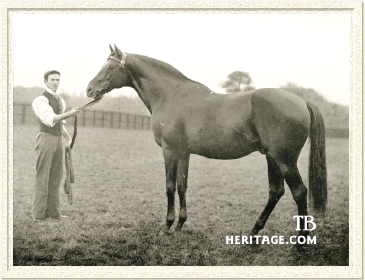 |
|
|
Kendal, one of Bend Or's most attractive sons, was a very good juvenile runner sidelined by a career-ending injury at the end of his first season, leaving him to prove his worth in the breeding shed, while his crop-mate and near relative, Ormonde, went on to glory on the racecourse. Kendal did show he was equal to his turf record and pedigree, especially during the few years he spent at stud in Ireland, where he got the English Triple Crown winner Galtee More and many other good runners besides, and in the eight years he spent in Argentina. He was leading sire twice in Ireland, leading sire in both Great Britain and Argentina in different years, and an excellent broodmare sire, posthumously topping the list twice in Argentina. As with many good stallions from the late nineteenth century, we know him now through the descendants of his daughters, but for a few years, with more than a few good stallion sons, it appeared he would continue the Bend Or sire line.
Kendal was born at at the Duke of Westminster's Eaton Stud during its heyday. The Duke's great chestnut stallion, Derby winner Bend Or, had retired there from the turf in 1881 and was first put to mares in 1882, many of those in his limited first season book owned by the Duke. Kendal and the outstanding runner Ormonde, both out of mares by Macaroni -- who had been bred at Eaton -- were in Bend Or's first crop. Macaroni, racing for Richard Naylor, had an unbeaten three-year-old season, in which he won the Derby and the Doncaster Cup, and had served as a stallion at Naylor's stud until sold to the Rothschild Mentmore Stud, where he was principal stallion until his death in 1887.
Kendal's dam was Windermere, a Macaroni daughter, out of Miss Agnes, of the well-known Agnes family that produced so many winners and makes up most of Family 16. She was bred in Yorkshire, at the Sledmere Stud of Sir Tatton Sykes, and was a half-sister to Polly Agnes (dam of Lily Agnes (dam of Ormonde, Ornament and Ossory), Tiger Lily (dam of Martagon), Jessie Agnes, etc., the first two notable broodmares), and to Manchester Cup winner Little Agnes, another superior producer, and was a sister to Frivolity, who won the Middle Park Plate, and to the colt Couronne de Fer, who was second to George Frederick in the 1874 Derby. Sold as a yearling in 1871 to Mr. Bruton, Windermere won Newmarket's Filly Stakes as a juvenile, her only start that year, and placed third to Cecilia in the One Thousand Guineas at age three.
In the Duke's Eaton Stud, where she spent her entire broodmare career, Windermere bred Muncaster (1877, by Doncaster), who was beaten by a head by Petronel in the Two Thousand Guineas (later twice leading sire in Germany), and his sister Thirlmere (1881), who was fourth dam of the great steeplechaser Golden Miller and ancestress of some good winners in Spain. Kendal was born in 1883. His younger sisters Golden Agnes (1885) and Rydal (1886) both bred on; Rydal was dam of Prince of Wales's Stakes winner Rydal Head, grandam of St. Leger winner Troutbeck, and through her daughter Rydal Fell (1903, by Ladas), ancestress of many great runners, including the outstanding race mare of the 1930s, Pearl Cap and her half-brother, Prix du Jockey Club winner Pearl Weed.
Kendal was a big colt, and definitely on the leg at age two, but described by Porter as light of bone, and "unduly heavy about the neck." As a stallion he let down nicely, prompting one turf writer to say he was "...about as beautiful a specimen of the modern stallion as is possible to find."
Kendal on the Turf
Kendal was kept by the Duke, and placed in training with John Porter at Kingsclere. Kendal was a very promising juvenile, but never got a chance to realize his potential in later years. He ran eight times in 1885, and won six good races. His first race was the Mostyn Plate at Chester, where he beat four other youngsters. He then ran second, to Saraband, in Ascot's New Stakes. After that came a succession of victories: the Stockbridge Post Sweepsteakes, beating two others; Newmarket's July Stakes, beating a high class field of eight others, including Mephisto and St. Mirin; Goodwood's Ham stakes over six furlongs, beating two others; York's Great Breeders' Convivial Produce Stakes (5 furlongs-44 yards), and a walk over in Doncaster's Municipal Stakes. Not long after the Municipal stakes he hit his leg during a gallop, and in his last race, Newmarket's Rous Memorial Stakes, he ran fourth. It appeared his leg would not come sound, and he was retired from the turf, never to fufill his promise.
Kendal was of an age with the great, never-beaten (on the race course) Eaton product Ormonde, to whom he was closely related, both being by Bend Or and out of Macaroni daughters from the Agnes Family. He was tried by Porter against Ormonde in early October of his juvenile year, before he was injured. Ormonde at that time was "practically untried," and reportedly not fit. Receiving 1 st. - 1 lb. from Ormonde, Kendal won the trial by a length, with the three-year-old Whipper In ( 9 st. - 6 lb.) a length behind Ormonde, and the four year old Whitefriar ( 9 st. - 6 lb.) two lengths further back. Although Porter never doubted Ormonde was the superior horse, the trial did raise the question regarding just how good Kendal would have been, the answer to which would never be known.
Kendal in the Stud
When Ormonde won the St. Leger, Westminster offered Porter a gift -- his choice of £500, or Kendal. Porter chose Kendal and promptly leased him as a stallion to Lord Wolverton for £300 per year for three years, with the option to purchase the horse at the end of the lease. Wolverton died before the lease ended, and Kendal returned to Porter. Kendal was then purchased for £3,000, in 1888, and installed in the famous Knockany Stud of Bruree, Co. Limerick, Ireland, owned by John Gubbins, where many famous Irish horses had been bred, and where Juggler, Uncas, and other good stallions stood over the years. The famous half-bred stallion May Boy was a product of the Knockany Stud. St. Florian (sire of Ard Patrick) and May Boy were also on the roster when Kendal was a stallion there.
In 1893 Kendal was sold back to England to Major James E. Platt for 20,000 guineas, but not before Gubbins' useful broodmare Morganette was bred to Kendal; the following year she dropped GALTEE MORE, and it was his success as an English Triple Crown winner in 1897 that propelled Kendal to the top of the leading sire's list in the U.K. While in Ireland Kendal also got other good winners on the flat, which put him at the top of the sire's list in Ireland with number of races won in 1891, and at the top with amount of money won in 1894. While there he also got some very good jumpers, many from daughters of Gubbin's stallion Uncas, who until 1887 was the preeminent sire of chasers. Some of Kendal's sons got top steeplechasers, including a Grand National winner, Shannon Lass.
Kendal was not as successful as a sire in England, but he did get TREDENNIS, born at Platt's Bruntwood stud in Cheshire in 1898; Tredennis was a handsome colt of no use on the turf, but he became a good stallion in Ireland.
Kendal, already well-advanced in years, was purchased in 1901 by Raul Chevalier, one of the heirs to the famous Argentinian stud, Ojo de Agua, located in the Balcarce district. Kendal was sent to Argentina to replace Gay Hermit, who had recently died; other stallions at Ojo de Agua over the course of its long and successful history included the imported horses Pietermaritzburg, Cyllene, Polar Star, Your Majesty, Sandal, and the great Argentinian-bred stallion Congreve. Kendal died in 1908, the year he was leading sire in Argentina, and he would posthumously top the leading broodmare sire's list twice in Argentina, in 1918 and 1919.
Kendal in Ireland
In his first two crops Kendal got some youngsters that won some of the best races in Ireland. The star of these first couple of years was the bay filly CHRISTABEL (1889, out of Chrysalis, by Lecturer; properly by Lyric or Kendal). For William Brophy she won two good juvenile events, the Railway Stakes and the Anglesey Stakes, and one other race; with her earnings she was the top money winning horse in Ireland in 1891. WORDSWORTH (1889, out of Lady Pitt), another good juvenile owned by Brophy, won the one mile Beresford Stakes. ROY NEIL, (1889, out of Sylva) won the Irish Derby in 1892.
RED PRINCE II was also in the 1889 crop; he was out of the 1880 Grand National Steeplechase winner Empress, by Blood Royal (winner of the Downshire Cup at Punchestwon carrying 14 st. -10 lb.), and started his career by winning the National Produce Stakes as a juvenile. At age three, he won the Royal Whip (then run over four miles), held at the Curragh. At age four he proved a precocious jumper, winning four races over fences, including Cork Park's Grand Sand Handicap chase over 2-1/2 miles, and Manchester's (England) Lancashire Steeplechase over 3-3/4 miles, where he ran in eight lengths ahead of the field. He was owned by Henry E. Linde of Eyrefield Lodge on the Curragh, a top Irish trainer who had his own private steeplechase course at Eyrefield for schooling youngsters. Linde's first Grand National winner was Red Prince II's dam, Empress, named in honor of Empress Elizabeth of Austria, who would visit Ireland to hunt. Linde also trained the 1881 Grand National winner Woodbrook, Too Good, winner of the Grand Steeplechase de Paris and second in the Grand National, and many other top chasers.
Red Prince II was said to be "difficult to train" due to his conformation, described as heavy-shouldered and top-heavy, the latter certainly due to his sire. In the stud he "got good-looking horses" that resembled himself, almost all of which were put to jumping, and he was leading sire of jumpers between 1904 and 1909 in Great Britain. His winners included 1905 Irish Grand National winner Red Lad, who ran second to Ascetic's Silver in the 1906 Grand National; Conyngham Cup winners Famous (in 1906) and Ruddygore (1914), and 1913 Galway Hurdle winner Red Damsel.
Kendal's son BUTTERSCOTCH (1889, out of Sweetness, by Xenophon) was also in the 1889 crop. He was used as a jumper sire, and his best was the beautiful brown mare Shannon Lass, out of the Uncas daughter Mazurka. She was bred by J. Reidy and ran on the flat for three years, and then was sold to Ambrose Gorham of Brighton, for whom she won eight steeplechases, trained by Jem Hackett at Telescombe, Sussex: she won the 1902 Grand National by three lengths, beating Matthew and Manifesto, both more heavily weighted.
Kendal's daughter, the half-bred LIZZIE KENDAL (1889, Family H-B 11), bred in Daniel Moloney's stud at Knocklong, was out of an Uncas mare that was sister to Redpath, a winner of the Grand Steeple Chase de Paris. Lizzie Kendal was sold to Baron Grenier, of Gronde, Belgium, and she was hunted and raced both there and in Ireland until 1901, winning the Grande Steeplechase des Flandres, in Belgium, in 1898. Maloney re-purchased her in 1901, and sold her in 1903 to John M'Inerney of Co. Clare. In the the stud she produced Thomond (1895) before she was shipped to Belgium; he won thirteen races, including the Dudley Plate, and was sold to India where he won a number of good hurdle races. Lizzie Kendal later produced Olive (1907, by Santoi), dam of The Kiwi (1918), winner of the Irish Oaks and later a winner over fences. Another offspring of Kendal out of Lizzie Kendal's dam was KNOCKALONG (1890), a winner of two National Hunt races on the flat, and of four hurdle races.
Another steeplechase matron from Kendal's 1889 crop was MEANUS (from Buda, by Balfe), whose unnamed daughter by Bushey Park produced the gelded Vermouth. Vermouth won the Imperial Cup ( over hurdles) at age four at Sandown, and another hurdle race a few days later at Cheltenham, then ran on the flat, winning at Alexandra Park and placing second to Annecy in the Great Metrpolitan Handicap at Epsom, and went on to win the Manchester's Lancashire Steeplechase and then the 1916 wartime Grand National at Gatwick. MEANUS was sister to GREENLAWN (1891), a good sprinter that won the Leopardstown Grand Prize over five furlongs at age three; GREENLAWN was the leading sire in South African in the 1906-7 season. And another steeplechase matron in this crop was ALANNA (from Mauvorneen by Master Richard), sister to BREEMOUNT'S PRIDE, who bred a really great chaser in Rathnally (1905), who won many races and was second in the Grand National.
In the 1890 and 1891 crops Kendal's bay daughter LAODAMIA (1890, from Chrysalis by Lecturer), and his son BLAIRFINDE (1891) were the stars. LAODAMIA was bred by William Brophy, and for him won the Curragh's five furlong Waterford Testimonial Stakes for juveniles in 1892. When Brophy died, she was sold at Goff's for 3,500 guineas, a record price that would not be bested for 37 years. She went on to win the Derby Cup and the Doncaster Cup, and retired to Sandringham, the stud of the Prince of Wales, where she was not a successful broodmare, although one of her tail-female descendants, Recitation, won the French One Thousand Guineas in 1981.
Another good winner was Kendal's daughter LADY KENDAL (1890), who won the Irish Cesarewitch in 1893. Another daughter, HEATH COTTAGE (1891, out of Canterbury) won the Princess of Wales's Cup.
FIZZER (1891, out of Queen of Beauty by Ben Battle) did not place on the flat, or over hurdles, but bred Fiz Yama (1909), who won the Cesarewitch Stakes handicap and Ascot's Queen Alexandra Plate. STAR ACTRESS (1891), sold to the U.S., produced Mrs. Kendal (1898), who was sent to England to race, where she placed twice in seven starts as a juvenile in minor races, and then bred Atmah, a winner of Newmarket's One Thousand Guineas.
|
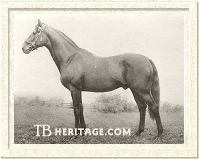
Blairfinde
| |
The bay BLAIRFINDE (1891), was out of Morganette, by Springfield, a poorly performed race mare that would prove to be an outstanding broodmare, dam of three classic winners, of which Blairfinde was the first. He was bred at Gubbins' Knockany Stud. Blairfinde was sent to Sam Darling's Beckhampton stable in Wiltshire, Gubbins having switched his patronage to Darling from Lushington at Telscombe, Sussex, as Blairfinde was coming two. A big, growthy colt, Blairfinde ran twice unplaced as a juvenile, and at age three he won one race, the Irish Derby, coming in ten lengths ahead of the field. Due to "training difficulties" this was his last race.
|
BLAIRFINDE spent the early part of his breeding life at Beckhampton, where he got Dibs, a winner of the Ebor handicap, and then in Ireland, where he got a few winners, including Blairmore, winner of the 1903 Irish Cesarewitch and Blair Royal, winner of the 1910 Irish Oaks. BLAIRFINDE'S sister, born in 1890, MARIETTA, won several races, including the Halnaker Stakes.
Winners born in 1892 by Kendal included the juvenile runner ANGELUS (1892, out of Vesper Bell), owned by Colonel Paget, whose three victories in 1894 included the Railway Stakes at the Curragh, which made him the leading money-winner in Ireland that year. Another juvenile winner by Kendal that year was the filly KENDALE (1892, out of Vanquish, by Victor), winner of the Curragh's Waterford Testimonial Stakes. THE ALSATION (1892, out of Miss Emily, by Thurio), won the Grand Handicap International d'Ostende. |
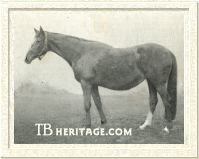
Kendal Belle
| |
KENDAL BELLE (1893, bred by Gubbins, H-B 1 Family) was out of the half-bred May Day, by Uncas, and so a half-sister to the famous May Boy, who later served as a stallion at Knockany Stud. Sent to England, she ran unplaced in her one race, and then went back to Bruree, and was put in the stud where she helped make the May Day family the most successful half-bred family to that time. She was the dam of ten winners, including two good stallions. One was the sturdy, weight-carrying sprinter Prospector (1905, by Pioneer), winner of five races in England to age four, including the Surrey Stakes, Kempton Park's Princess Plate, and the Thames Handicap at Windsor. He got a number of winners, many of them precocious juveniles like himself.
|
Kendal Belle's second good stallion son was Shogun (1910, by Santoi), a very good juvenile in England whose wins included the Woodcote Stakes, the Coventry Stakes and the Lavant Stakes, and at age three the Ascot Gold Vase and Liverpool's Knowsley Dinner Stakes, among others, before breaking down during the running of the Doncaster St. Leger. At stud in England, he got a number of winners, including the great race mare and producer Verdict . Kendal Belle also produced Forerunner II, winner of the Wokingham Stakes, the Hull Cup, and the Grand Criterion d'Ostende, and other races; Belle of Bruree, winner of Liverpool's Joliffe Stakes, and a number of other winning daughters that bred on.
Other good Kendal offspring from 1893 included HATTIE (1893, from Skarte), who won the Londonderry Plate over 5 furlongs for juveniles at Leopardstown and RINVANNY (1893, from Deception, by Arbitrator), winner of the Curragh's Anglesey Stakes for juveniles over six furlongs. MISS CARDEN (1893, from the Lord Gough daughter Lady Carden) did not race, but in the stud bred the great weight-carrier, Juliet II (1903), a good juvenile whose wins included the Railway Stakes and Waterford Testimonial Stakes, and at age three winner of the Irish Oaks.
Also in this crop were KILLYLEAGH (1893, out of Abanico, by Rosicrucian), who became a useful sire of flat runners and chasers and hurdlers, including 1915 Irish Grand National winner Punch and Killeagh, the 1906 winner of the Irish Derby. Kendal's daughter BREEMOUNT'S PRIDE (1893, from Mavourneen by Master Richard), was put to fences, and won five of her 22 races, despite a serious problem with roaring, including the Irish Grand National in 1897 and the Grand Lancashire Chase at Manchester in 1899, and was third in the 1900 Grand National Steeplechase. Breemount's Pride later produced Hackmount, winner of 14 of his 29 starts, and Judina, who won four races in 23 starts. |
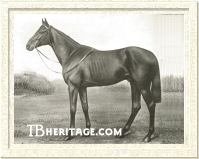
Galtee More
| |
GALTEE MORE (1894), in Kendal's last Irish-born crop, was a brother to BLAIRFINDE, and cemented Morganette's reputation as a good broodmare (she would later, to the cover of St. Florian, produce Derby winner Ard Patrick, later a four time leading sire in Germany). Gubbins sent the big handsome colt to Sam Darling at Beckhampton for schooling, and in his first season he won four good juvenile races, including the Hurstbourne Stakes at Stockbridge, Goodwood's Molecomb Stakes, Doncaster's Rous Memorial Plate, and Newmarket's Middle Park Plate, where he beat Velasquez by six lengths. Velasquez, however received championship honors that year. |
The next season GALTEE MORE won every race he entered, but one. He beat Velasquez by four lengths in the Two Thousand Guineas, won the 1-1/4 mile Newmarket Stakes, took the Epsom Derby by two lengths, moved on to Ascot where he won the Prince of Wales's Stakes (1 mile-5 furlongs), backed off to a mile and 1 furlong to win Sandown Park's Sandringham Cup, beat the great filly Chelandry in the Doncaster St. Leger (then 1-3/4 miles), and then won the 1-1/4 mile Sandown Foal Stakes. His last race of the season was the Cambridgeshire Stakes handicap over 9 furlongs, where, not surprisingly, he was heaviest weighted (9 st. - 6 lb.), carrying 26 pounds more than any other three year old in the race; he was unplaced. The winner, Comfrey, who was carrying 7 st.-2 lb. GALTEE MORE had run a nearly unbeaten season, and collected the English Triple Crown races in doing so.
In the spring of 1898 a delegation from the Russian government, headed by General Arapoff, visited Beckhampton during their search for a high-class stallion, for which they were authorized to pay 10,000 guineas. They went to look at Captain Greer's Kilcock, whose best win had been Newmarket's July Cup, but then they spotted GALTEE MORE, who was kept in training at Beckhampton with the Ascot Gold Cup as the goal. After negotiations, including the embassy's return to Russia to consult and get permission to spend an additional 10,000 guineas, and some instances of near termination of the sale upon their return, the Russian government secured GALTEE MORE for 20,000 guineas. While in Russia he got a number of good runners, including Irish Lad, who in 1903 became the highest money winner in Russia to that date.
In 1904 GALTEE MORE was sold to the German government for £14,000, and was installed at the state stud at Graditz. He got many good runners there, including Deutches St. Leger winner Fervor, who later was leading sire in Germany between 1923 and 1926. GALTEE MORE daughter, Orchidee II, won the German Oaks, and in the stud produced the champion runner Oleander, who later led the sire's list in Germany nine times. GALTEE MORE broke his leg at the Hoppegarten railway station on January 30, 1917, and was destroyed; he had just completed his journey by rail from Gratditz to take up stud duty at the Union Stud at Hoppegarten. With a son and grandson leading sires in Germany over a span of thirteen years, he had an enormous influence on German bloodstock breeding, but the sire line, through Fervor, died out when his grandson, German Derby winner Solo (1941) failed to produce a good son.
Another youngster in Kendal's last Irish crop was MAYBERRY (1894), a half-sister to KENDAL BELLE. She did not run, but got some daughters that got winners on the flat and over fences, and a son, Mayfowl (1905, by Wildfowler), a winner on the flat and over hurdles who was sold to India in 1910, where he twice won the Viceroy's Cup. Another youngster in this crop was KENDAL BEAUTY (1894, out of Queen of Beauty by Ben Battle), a sister to FIZZER; she did not place in her five starts as a juvenile, and was sold to France in 1898, where she bred Keltoum (1901, by Champaubert), who won six races and later produced the good staying filly La Francaise (1907), winner of the Prix du Cadran, the Grand St. Leger de France and the big distance race, the Prix Rainbow, twice, and nine other races. Her tail-female descendants included the Grand Prix de Paris winner and stallion Deux Pour Cent (1941, leading sire in France in 1950), and the great German-owned colt Le Glorieux (1984).
Kendal in England
Kendal spent seven years in England, and, supported by some very good mares, got a few good runners and some sons who were fairly successful stallions, but nothing to match GALTEE MORE. His most significant son born during these years was TREDENNIS, who was useless on the turf, but in the stud (in Ireland) so well exceeded expectations that for a while he was considered the son who might continue the Bend Or sire line.
|
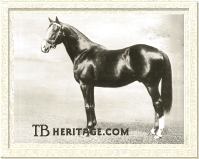
Tredennis
| |
TREDENNIS (1898) was the last foal out of the great broodmare St. Marguerite, by Hermit; she died the day after he was born, and he was fostered by a cart horse. St. Marguerite had already produced a number of winners, including the terrific race filly and dual classic winner Seabreeze (by Isonomy) and her sisters, Yorkshire Oaks winner Antibes and the good juvenile filly Riviera, and the winner Roquebrune (by St. Simon), who became the dam of the English Triple Crown winner Rock Sand.
|
Bred at Bruntwood by Platt, who had purchased St. Marguerite four years earlier, Tredennis was sent to the Doncaster yearling sales and was unintentionally purchased for 2,000 guineas by Captain Machell.
Tredennis was sent for training to Major Beatty's Bedford Cottage stables at Newmarket, but he proved "too cheeky" to school and was sent to Wiltshire to grow up. He was brought back to train for his thre year old season, but proved "too slow for words," running unplaced in two races, and the following year was again unplaced in a welter handicap. Machell died soon after this, and Tredennis was sold at Newmarket spring sales in 1902 for 100 guineas to Sir Charles Pulley. In the fall, realizing Tredennis would never win a race, Pulley resold the horse to Albert Lowry of Bachelor's Lodge, near Navan, Co. Meath, whose stallion Le Noir, had died after being kicked by a mare. Tredennis began his stud duties -- at a fee of £5 -- in Ireland in 1903, "with nothing but his looks and his pedigree to recommend him."
Supported by his owner's mares, Tredennis had four foals in 1904, and five in 1905. In 1906 he had a crop of nine, one of which was Lowry's Bachelor's Double, the son of a non-winning twin, Lady Bawn (by Le Noir, also a non-winner). He won his first race as a juvenile, the Grand Prize at Leopardstown, and went on to win the Railway Stakes and Phoenix Park Nursery Plate, his only other races that season. After that Tredennis became a popular stallion in Ireland, and his stud fee rose to 19 guineas in 1910, and at its peak the fee was 200 guineas. He was leading sire in Ireland in 1914 (races won), in 1921 (money won), and 1922 (races won). In the general U.K. lists, he was leading sire of broodmares in 1926, due largely to his grandson Coronach's victories; he reached fifth place in the U.K.'s list of leading sires in 1922, when his best running son, Golden Myth, was winning at age four. Most of his offsrping were distance runners, many of which had long careers on the turf, and several good ones also had speed, as well as endurance, and won such sprint races as the Eclipse Stakes. Tredennis died at Bachelor's Lodge in April, 1926.
The Tredennis son Bachelor's Double went on to win nine of his seventeen races over four seasons, placing four times, including the Irish Derby, Epsom's City and Suburban Handicap, the Royal Hunt Cup, and Kempton's Great Jubilee Handicap. He had a successful stud career, and led the sire's list in Ireland for number of races won in 1919, with ten offspring winning 23 races, and was again at the top in Ireland in 1920 in terms of monetary winnings, with nine youngsters winning 17 races worth £4,992. Most of his youngsters were versatile and sturdy winners that ran three seasons or more, with a tendency to prefer a distance of ground.
Bachelor's Double's son, Argosy, was later a good sire of winner son the flat and over fences in Ireland, and Argosy's son Embargo had a son that won the Irish Grand National and a grandson that won the Cheltenham Gold Cup. In France, Bachelor's Double's son Comrade won the prestigious Grand Prix de Paris and the Prix de l'Arc de Triomphe. In England, his daughter Love in Idleness won the Epsom Oaks. Another son, Backwood, went to Australia, and won the great distance race, the Melbourne Cup. With the exception of Argosy, this branch of the Kendal line petered out.
Some of Bachelor's Double's daughters proved to be outstanding broodmares. Double Life (Bachelor's Double - Saint Joan) was a winner of six races, including the Cambridgeshire Stakes, and became a significant matron, dam Persian Gulf and Precipitation, among other winners and producers. Commedienne (1913, from Altoviscar) won her first four races as a juvenile and in the stud produced outstanding runners Comedy King (Lingfield Park Plate, Great Yorkshire Stakes, and other races, later sire in France), Call Boy (1924, winner of the Middle Park Plate, Epsom Derby and other races, later nearly sterile stallion), and Call Girl (winner, dam of winners in America, ancestress of U.S. Nassau Stakes winner Optimistic Lass).
Tredennis' son Golden Myth, the versatile winner of the premier sprint event, the Eclipse Stakes, the Ascot Gold Vase and the 2-1/4 mile Ascot Gold Cup at age four, was later a disappointing sire, although he led Ireland's sire list (money won) in 1931 with three winners of four big races, and son Sea Serpent (1928) later won the Irish Derby and led the Irish sire's list in 1939. Tredennis' son, Soldennis, was the champion in Ireland in 1921 and winner of 24 races over four seasons, including the Irish Two Thousand Guineas and Irish St. Leger, and the Ayr Gold Cup, and was later a successful sire in Ireland, leading the Irish list in 1930 (money won) and in 1936 (races won), but he did not get a successful sire son. However, Soldennis' half-bred daughters (both Family B-4) Soloptic, (winner of the Irish One Thousand Guineas, Irish Oaks and other races in 1929) and the speedy Solerina (July Handicap, Goodwood Steward's Cup, Newmarket's Challenge Stakes) were very good producers.
Tredennis' son Red Dennis (1911) won two small races at age three and was sent to Australia where he won one race in five starts; in the stud, advertised as "the handsomest horse in Australia, he got one good winner, Sister Olive (1918), who won the Melbourne Cup and was second in the Australian Cup and was later the dam of winners (she was tail-female ancestress of Tobin Bronze).
None of these promising sons of Tredennis established a long-lived sire line.
Other Tredennis runners included Pons Asinorum, a good juvenile in Ireland that later won the Doncaster Cup; the gelding Hornet's Beauty, winner of thirty-one races over six seasons, and Dunholm, who won seventeen races. Bachelor's Wedding, a brother to Bachelor's Double, won the Irish Derby in a canter, and was sold to India, where he twice won the important Viceroy's Cup. Tredennis' son Laoghaire won Ireland's Royal Whip, then a 4 mile race, in 1913. His daughter, Bachelor's Fiasco, won the Royal Whip the next year.
Tredennis' daughter Wet Kiss, sister to Soldennis, won several races and in the stud bred a versatile son in the dual classic winner Coronach, whose victories included the Eclipse Stakes, the St. James's Palace Stakes, the Epsom Derby and the Doncaster St. Leger. Tredennis' daughter Clodaugh (1916) produced Sceptical (1922, by Buchan), unplaced in thirteen starts and sent to the U.S., where she bred the good handicapper Chop Chop, sire of the great race mare Canadiana (1950), Canadian Horse of the Year Victoria Park (later a leading broodmare sire), and other good ones. The good Irish stallion Mustang was a tail-female descendant of Tredennis' daughter Honey Bee. Other Tredennis daughters also bred on.
Kendal's Other English-bred Offspring
Other Kendal sons bred in England included ERCILDOUNE (1896, out of Hampton daughter Maid Marian, dam of Polymelus), winner of the Duke of York Stakes. SIR EDGAR (1898), bred by the Duke of Portland from his One Thousand Guineas winning daughter Semolina, won Chester's Dee Stakes, and then was sold to J.R. O'Connor and installed at his Cashel stud in Co. Tipperary; he was a leading sire in Ireland (money won) in 1913, and sire of the 1909 Irish champion Lady Edgar, the half-bred Irish Oaks winner May Edgar, Ireland's Phoenix Stakes winner Courier Belle, and Lady Fanchon, who was dam of 1930 Irish Grand National winner Fanmond. GASCONY (1899, out of Gas, by Ayrshire, and so half-brother to Derby winner Cicero and Valve (dam of One Thousand Guineas winner Vaucluse)) won four races and was sent to Austria where he got Eva (1912 Austria Preis winner), Napkelet (dam of Naplopo, 1925 Austria Preis winner and 1926 Magyar (Hungarian) Derby winner), Michaela (1920 Oesterreichisches Stutenpreis winner), Austrian Trial Stakes winners Hadd-lassuck and Banat (dead-heat), and other good runners.
Kendal's best running daughter in England was ICECAPADE (1899, out of Oaks winner Lonely, by Hermit), who won the Yorkshire Oaks and the Ascot Gold Vase. SWEET MARJORIE (1896, sister to Tredennis) won Liverpool's St. George Stakes and Stockton's Durham County Produce Stakes, and ran second in Doncaster's Park Hill Stakes, among other places, and in the stud produced the handsome Simon Square (1904, by St. Simon), a winner of two races and later a pretty good broodmare sire.
Kendal did get some broodmares of significance while in England, including the unraced LADYLAND (1898, from the Ayrshire daughter Glare); in Germany she produced Landsturmer, winner of the Podbielski-Rennen, Ladylike, winner of the Preis der Diana and the Oppenheim-Rennen (later tail-female ancestress of Ladro and Lampos), and Laland (1917), who won the Henckel-Rennen and was later dam of many good winners, including one of Germany's best-ever racemares, Nereide (1933, unbeaten at ages two and three, including German Derby in record time), who in turn produced Nordlicht and Nuvolari (both in-bred to Kendal). LINDAL (1902, out of Springfield's excellent daughter Sunrise), in his last English crop, ran unplaced in top company, but in the stud produced Limond and Sandal. Limond, by Desmond, a winner of Newmarket's Exeter Stakes as a juvenile, was sold to New Zealand where he was leading sire in 1930-31. Sandal, by William the Third, won a race at age three and was purchased to Argentina, where he got Sierra Balcarce, the first filly to win the Argentine Triple Crown and Macon, a top runner and winner of fifteen successive races and later a leading broodmare sire.
Kendal was leading sire in Argentina in 1908, and twice leading broodmare sire, in 1918 and 1919.
|
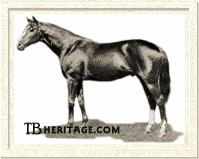
Bronce. Photo courtesy
| |
The chestnut BRONCE (1905) was a major contributor to Kendal's leading status in Argentina in 1908, winning the Gran Premio Carlos Pellegrini and the Premio ComparacŐon. He was later Kendal's best sire son in Argentina, standing at stud at Haras Bronce. His dam, Promise (1896, by Gay Hermit), also produced Pirita, winner of the Gran Premio Seleccion, and dam of two good winners, Fair Play and Gaulois. |
Other good Kendal youngsters in Argentina included FLOREAL (1902), who won the Gran Premio Nacional, the Premio General Pueyrredon, and the Capital Y Palermo; CASIOPEA (1906), winner of the Gran Premio Jockey Club and Olavarria; ALDEANA (1908), winner of the Polla de Potrancas, the Cl∑sico Libertad and other races; RIO DO ORO, winner of the Oto“o and Rivadavia. Kendal's son MARTE (1902), winner of twenty-two races, became a sire of top sprinters in Chile, and another son, BARSAC (1904), who won the Centenario, the Premio Miguel Martinez de Hoz y Palermo, got a number of good winners in Chile, including Bishop, and Le Rhone. Other Kendal winners in Chile included PINCHE, winner of La Copa and the Gran Premio Internacional, and PERFECTA (1907), who won the Chilean Oaks. Some Kendal daughters, such as DECEPTION (1903, from Promesse), established long-lived families in Argentina; DECEPTION was tail-female ancestress of Boran (1979), winner of the Gran Criterium in Argentina.
Kendal was a worthy son of Bend Or, full of promise as a runner until his career-ending injury, and he got of one of the best racehorses at the end of the nineteenth century, GALTEE MORE. He got other sons in Ireland, England, and Argentina that continued his line for a generation or two in various countries, and one, Red Prince II, had an impact on steeplechasing lines. But it was his daughters, and those of his sons, notably in Germany, that spread his influence throughout the world, and it is through them that he is seen in pedigrees today.
--Patricia Erigero
|
|
|
|

